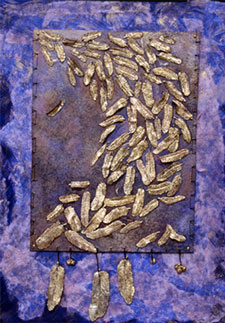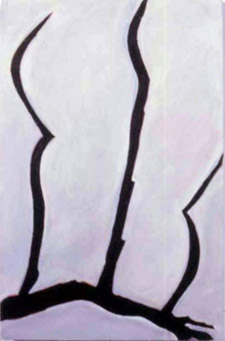| |
Reprinted
by permission from
The Messenger,
Diocese of Central New York
ECVA 2003
By Susan Dixon
When
you attend your normal service in an Episcopal church, what do you
see? Does your church have a work of art that gives the service
meaning for you or helps you to understand a Gospel story? Do you
notice how the vestments the clergy wear highlight parts of the
liturgy? Do you know if there are any artists in your church? Does
your church own any work made by an artist from your community?
These and
many other questions occupy the minds of the people involved in The
Episcopal Church and Visual Arts, an organization formed to explore
issues related to the visual arts and the church. This group, which
includes several members of the Diocese of Central New York, works to
find and lift up Episcopal artists, to give them an opportunity to
form a network, and to encourage Episcopal churches to become
conscious about the visual arts and even to commission work from
artists. To do this ECVA began with a conversation among several
interested people who decided to launch a website as the most
effective way to reach people quickly across the country. ECVA
launched its first exhibition in Advent of 2000 and has launched an
exhibition each quarter since then, all drawn from the work of
Episcopal artists.
This
liturgical year began with an exhibition of artistic responses to the
collects of Advent, Christmas, and Epiphany. An example from this
exhibition is Barbara Desrosiers, Seraphimatic Contrail. Barbara draws
upon her experiences as the wife of an Army chaplain stationed in
Korea to create mixed media pieces inspired by Korean spiritual
traditions. In Seraphimatic Contrail she shows us the energy path of
the seraphim.
This Lent
ECVA featured a number of visual representations of the Stations of
the Cross assembled as a teaching exhibition by its curator, artist
and Episcopal priest Thomas Faulkner. This exhibition shows artists
working in different styles with curatorial commentary that places
these styles in historical context. John Moody’s Stations use the
forms of bare branches as abstract focuses of meditation.
Other
exhibitions have included the themes of the cross, darkness and light,
icons, banners, responses to September 11th, illumination, and
community stories. The most recent exhibition, Lift Up Your Hearts!,
explores the particular gifts of the Episcopal Church as seen in the
work of Episcopal artists. Because the exhibitions are not physical.
they can stay on the web, so they are always available.
The
website also includes articles, resources, and a registry of Episcopal
artists. A recent addition to this registry is Beverly Wirth, a
liturgical artist and member of St. Andrew’s Episcopal Church in
Syracuse. Beverly believes, in the words of Isaiah 60:13, that the
call of the liturgical artist is "to beautify the place of the Lord’s
sanctuary."
Beverly
joins artists who work in as much variety as there is in the Episcopal
Church. Some use traditional figurative techniques, others work with
abstraction; some work alone in their studio while others create in
the context of a community. ECVA board chair, The Rev. Gurdon
Brewster, works in a studio close to his home in Newfield and then
casts his bronzes in a foundry in Vermont. ECVA board member Catherine
Kapikian is working with members of Grace Church, Baldwinsville, in
the diocese of Central New York to develop a piece called the Holy
Spirit Tapestry. Dozens of parishioners are contributing to this work.
Recently
ECVA was invited to work with the National Church Center to transform
the hall for this year’s General Convention into a space for worship –
and on a limited budget. The response was to use projected images to
create an atmosphere for worship appropriate to the theme of each
day's service.
This is a
particularly appropriate time for all this activity to occur. Our
culture is growing increasingly visual, which provides an opening for
an explosion of artistic creativity. ECVA’s work is drawing not only
artists, but writers, critics and teachers who can help reconnect us
with the imagery that surrounds many of us in our churches but whose
meaning may not be so familiar. Do we all know why a pulpit may be in
the shape of a bird? Why a pelican in a stained glass window is
tearing her breast? Why Episcopalians traditionally love Gothic
architecture?
The
Episcopal Church, with its rich heritage of art and imagery, is poised
to grow into a new generation of creative interpretation. Artists at
their best are visionaries, literally showing us a way into new
understandings. You can become a part of creating this vision. ECVA
began as a conversation among just a few people and you could begin in
the same way – find the artists and put your heads together. Contact
us for suggestions or to send ideas. Join the ECVA listserv. ECVA
extends an invitation to anyone who wants to be a part of this
inquiry, in any role – including simply asking questions.
(Now,
about that pelican…?)
Susan R.
Dixon, ECVA Program Director
|
|

Seraphimatic Contrail
By Barbara Desrosiers

First Station –
Jesus is condemned to death
By John Moody
(From his
Stations of the Cross) |
|
![]()